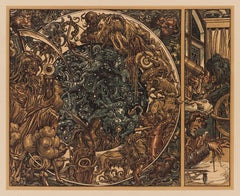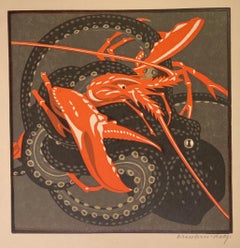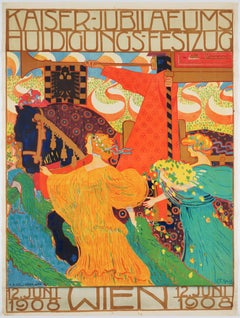Hanus Schwaiger Prints and Multiples
to
1
Overall Width
to
Overall Height
to
1
1
1,162
899
842
802
1
1
1
1
1
1
1
1
Artist: Hanus Schwaiger
Astronomy, Plate 120 from Gerlach's Allegorien, Vienna Secession lithograph
By Hanus Schwaiger
Located in Chicago, IL
Allegorien-Neue Folge was a serialized publication of artworks by a group of Viennese artists and students beginning in 1897. Martin Gerlach, its publisher, was inspired by the new rise of modernist design in Vienna and selected those who were demonstrating a new command of the style to contribute works to the series, including Gustav Klimt, Koloman Moser, Carl Otto Czeschka, and Hanus Schwaiger. Each plate explores a different theme or collection of topics, such as dance, astronomy, electricity, and graphic arts, which brought a new aesthetic of design to the traditional allegory genre.
Stone lithograph of Hanus Schwaiger’s Astronomie, published as Plate 102 in Gerlach’s Allegorien...
Category
1890s Vienna Secession Hanus Schwaiger Prints and Multiples
Materials
Lithograph
Related Items
LOBSTER and OCTOPUS (KAMPF - BATTLE)
By Norbertine Bresslern-Roth
Located in Santa Monica, CA
NORBERTINE VON BRESSLERN-ROTH (1891 1978)
KAMPF (BATTLE - LOBSTER and OCTOPUS) c. 1928
Color linoleum cut Signed in pencil. Image 8 5/8 x 8 11/16”
In excellent condition and full ...
Category
1920s Vienna Secession Hanus Schwaiger Prints and Multiples
Materials
Linocut
Original Vintage Secession Poster celebrating the emperor's jubilee
Located in Zurich, CH
Original Vintage Poster by the Austrian artist Ferdinand Ludwig Graf, a member of the Hagenbund. This Viennese artist association moved as soon a...
Category
Early 1900s Vienna Secession Hanus Schwaiger Prints and Multiples
Materials
Paper
$13,700
H 48.82 in W 36.42 in D 0.04 in
Ottokar Mascha Folio, plate 8: "Poster for the 1st Vienna Secession Exhibition"
By Gustav Klimt
Located in Chicago, IL
After GUSTAV KLIMT (1862-1918) THESEUS UND MINOTAURUS, 1898, final design submission for poster advertising the first exhibition of the Vienna Secession, (In Mascha, no. 8) As a cele...
Category
1910s Vienna Secession Hanus Schwaiger Prints and Multiples
Materials
Lithograph
$10,500
H 22 in W 18.5 in D 3 in
Gerlach's Allegorien Plate #116: "Force, Thirst, Love" Lithograph
By Carl Otto Czeschka
Located in Chicago, IL
after Carl Otto Czeschka, (1878-1960), Austrian
A leading member of the Vienna Secession and later the Wiener Werkstätte (Viennese Workshop), Carl Otto Czeschka was a vital figu...
Category
1890s Vienna Secession Hanus Schwaiger Prints and Multiples
Materials
Lithograph
$900
H 17.25 in W 13.75 in
Gerlach's Allegorien Folio, plate #58: "Sculpture" Lithograph, Gustav Klimt.
By Gustav Klimt
Located in Chicago, IL
As an artist trained in the applied arts, Gustav Klimt valued all forms of art, including the graphic arts. This final design from 1896 for inclusion in Allegorien published by Gerlach & Schenk demonstrates respect for artistic precedent and for a wide range of media and technique. The publication was printed in an unknown number of copies. Klimt’s rendering in latin of the title, “SCVLPTVR.,” with three-dimensional effect on the wall, is a figurative allusion to this medium as well as a literal reference to Ancient Rome. By doing the same with his signature and date in roman numerals on the right hand side of the image, Klimt places himself, The Artist, firmly in this linear and legitimizing context of art history and as its modern standard-bearer. Playing on Classical mythology and the story of Pygmalion, in which a statue comes to life, Klimt presents his modern Venus holding an apple. Klimt’s Venus exhibits a curvilinear softness; there are no angles. Klimt deftly shows the possibilities in a graphic image to give life to dark, wavy hair and tenderness to swelling breasts and belly. To further emphasize the allegory of thriving modern art, he contrasts his Venus with the cold, hard ancient classical head whose eyes are vacuous and whose hair is but a stylized mass of curls. Klimt’s living Venus stands in front of the large bust and large classical pillar upon which is a sculpture of a Sphinx and a Greek Attic bust. As if a gallery to represent sculpture’s “best of” through the ages, the upper horizontal panel includes bust depictions in marble, cast metal and wood...
Category
1890s Vienna Secession Hanus Schwaiger Prints and Multiples
Materials
Lithograph
$13,500
H 17.25 in W 13.75 in
Ottokar Mascha Folio: plate 11 "5th Secession Exhibition Poster" by Kolo Moser
By Koloman Moser
Located in Chicago, IL
after KOLOMAN MOSER (1868-1918) 5TH SECESSION EXHIBITION POSTER, 1899, (In Mascha, no. 11) A pivotal figure in early-20th century Austrian ...
Category
1910s Vienna Secession Hanus Schwaiger Prints and Multiples
Materials
Lithograph
$6,200
H 15.25 in W 11.5 in
Ottokar Mascha Folio, plate 18: "Shaw Oder Die Ironie Poster" by Egon Schiele
By Egon Schiele
Located in Chicago, IL
after EGON SCHIELE (1890-1918) SHAW ODER DIE IRONIE POSTER, C. 1912, (In Mascha, no. 18) Schiele’s poster is an advertisement for a lecture to be given ...
Category
1910s Vienna Secession Hanus Schwaiger Prints and Multiples
Materials
Lithograph
$6,200
H 15.25 in W 11.5 in
Gerlach's Allegorien Folio, plate #53: "Junius" Lithograph, Gustav Klimt.
By Gustav Klimt
Located in Chicago, IL
Contributors to Gerlach & Schenk’s publications valued design and innovation in the graphic arts just as much as they examined allegories as subject matter for exploration. Here, Gus...
Category
1890s Vienna Secession Hanus Schwaiger Prints and Multiples
Materials
Lithograph
$15,500
H 17.25 in W 13.75 in
Mädchen am Fenster. 1906-08.
By Oskar Kokoschka
Located in New York, NY
Mädchen am Fenster. 1906-08. Color lithograph printed on smooth card stock. Full margins. , signed by the artist in pencil, on the recto. Published by the Wiener Werkstätte, Vienna, with the printed postcard text on verso. Among Kokoschka's earliest prints were a series of 14 postcards, the current work and the following lot that he produced for the Wiener Werkstätte. Wingler/Welz 4.
Oskar Kokoschka was an Austrian artist, poet and playwright best known for his intense expressionistic portraits...
Category
Early 1900s Vienna Secession Hanus Schwaiger Prints and Multiples
Materials
Lithograph
Gerlach's Allegorien Plate #85: "Hunting" Lithograph by Carl Otto Czeschka
By Carl Otto Czeschka
Located in Chicago, IL
after Carl Otto Czeschka, (1878-1960), Austrian
A leading member of the Vienna Secession and later the Wiener Werkstätte (Viennese Workshop), Carl Otto Czeschka was a vital figu...
Category
1890s Vienna Secession Hanus Schwaiger Prints and Multiples
Materials
Lithograph
$900
H 17.25 in W 13.75 in
Gerlach's Allegorien Plate #51: "Summer" Lithograph
By Koloman Moser
Located in Chicago, IL
Koloman Moser
(1868 –1918), AUSTRIAN
Instead of applying his flair and art education solely to painting, Koloman Moser embodied the idea of Gesamt Kunstwerk (all-embracing art w...
Category
1890s Vienna Secession Hanus Schwaiger Prints and Multiples
Materials
Lithograph
Gerlach's Allegorien Plate #20: "Song, Love, Music, Dance" Lithograph
By Koloman Moser
Located in Chicago, IL
Koloman Moser
(1868 –1918), AUSTRIAN
Instead of applying his flair and art education solely to painting, Koloman Moser embodied the idea of Gesamt Kunstwerk (all-embracing art w...
Category
1890s Vienna Secession Hanus Schwaiger Prints and Multiples
Materials
Lithograph
$2,750
H 17.25 in W 13.75 in
Hanus Schwaiger prints and multiples for sale on 1stDibs.
Find a wide variety of authentic Hanus Schwaiger prints and multiples available for sale on 1stDibs. You can also browse by medium to find art by Hanus Schwaiger in lithograph and more. Much of the original work by this artist or collective was created during the 19th century and is mostly associated with the Expressionist style. Not every interior allows for large Hanus Schwaiger prints and multiples, so small editions measuring 18 inches across are available. Hanus Schwaiger prints and multiples prices can differ depending upon medium, time period and other attributes. On 1stDibs, the price for these items starts at $550 and tops out at $550, while the average work can sell for $550.


